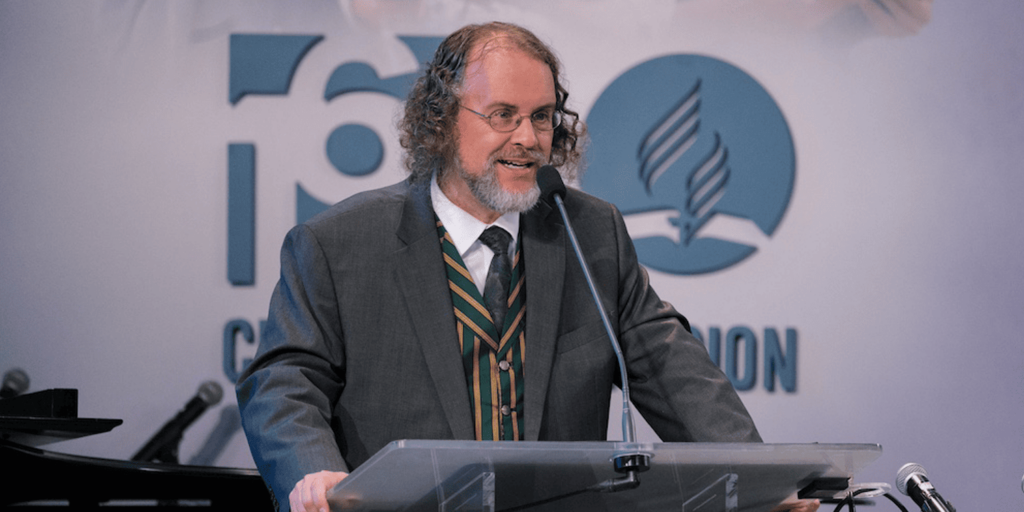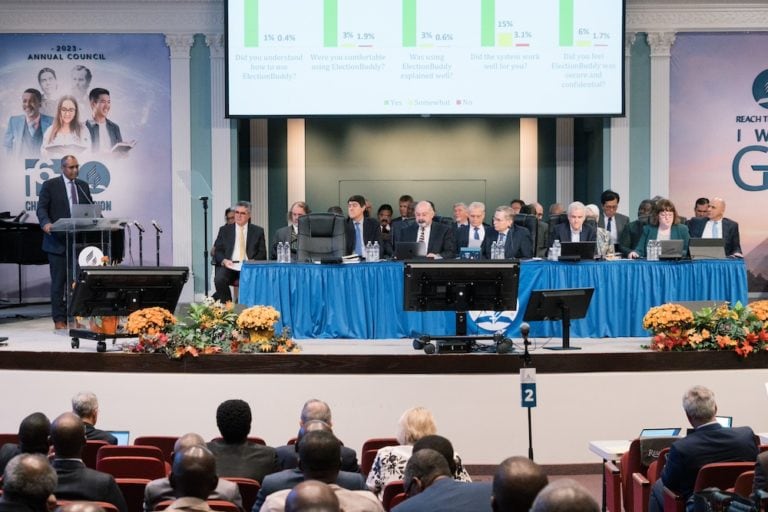There’s Still Much to Do to Reach All the World, Chief Statistician Says
David Trim shares member data trends and current implications for Adventist mission.
October 9, 2023 | Silver Spring, Maryland, United States | Marcos Paseggi, Adventist Review
On October 8, David Trim, director of the Adventist Church’s Office of Archives, Statistics, and Research of the General Conference, shared some key data about church membership and their implications for Adventist mission with hundreds of members of the church’s General Conference Executive Committee (EXCOM) at the 2023 Annual Council.
Trim’s presentation at the church headquarters in Silver Spring, Maryland, United States, showed membership statistics and trends and highlighted achievements and areas that reveal new or ongoing challenges for the God-given task of preaching the gospel of the kingdom “in all the world as a witness to all the nations.”
Member Accessions and Losses

David Trim, director of the Office of Archives, Statistics, and Research of the General Conference, shares data about church membership and their implications for Adventist mission. [Photo: Lucas Cardino]
Church growth, however, includes not only member accessions but also losses, he said. Trim displayed statistics that exclude deaths, showing that 2022 also marked the second highest number of losses with 961,000 members who left the denomination.
Trim explained that 58 years of data (since 1965) showed that in that period, 45.6 million members were baptized as Seventh-day Adventists but that at least 18.5 million decided to leave. “This means that our net loss rate is now 42.5 percent. In effect, more than 4 in 10 church members are slipping away.”
The world church continues to address this challenge, Trim said. “But it’s also a challenge to every church member, to be their brother’s keeper.”
From Global to Regional Trends
In the next part of his report, Trim moved from global trends to highlight some regional data. He first focused on the 10/40 Window, a region of the world where most of the world’s population lives but where Christians — and Seventh-day Adventists — are a minority.
Since the adoption of a global strategy in 1990, this region has been a priority for the worldwide Adventist Church, Trim reminded church leaders. He then shared data that show 20-year trends in the 10/40 Window against Adventist presence in the rest of the world.

General Conference undersecretary Hensley Mooroven introduces the morning business session of the 2023 Annual Council on October 8. [Photo: Lucas Cardino]
An analysis of the annual variations in the past 20 years shows that the number of members, congregations, and institutions increased, but the percentages remained essentially the same, Trim said. “In 2023, the proportion of the world’s population in 10/40 Window countries has risen slightly to 35 percent, but the proportion of church members in the 10/40 Window has slowly gone down to 12 percent. Congregations and institutions have fallen a fraction to 13.8 percent.” Thus, the situation remains mostly unchanged, he acknowledged.
“We praise God for the additional 890,000 church members we have in the 10/40 Window in 2023 in contrast with 2003,” Trim said. “But this doesn’t change the basic problem we face. How are we ever going to reach the world unless we reach the billions in the 10/40 Window?”
According to Trim, “these statistics show that there needs to be a refocusing of the church’s resources onto the countries of the 10/40 Window.”
Population per Member in Other Regions
In the next section, Trim shared 20-year trends about members as a percentage of population in different church regions of the world church. In showing these ratios, he reminded EXCOM members that lower ratios are better, because they show a higher number of Adventist members among the population in a particular region.
Statistics show that in 2003, there were 329 people per Adventist member in North America, 105 in Central America, 133 in South America, 1,955 in Europe, 198 in Africa, 1,522 in Asia, and 89 in Oceania. Trim then displayed a yearly comparison in the past twenty years to show a progression. Statistics from 2022 show that the ratios had changed to 305 people per Adventist member in North America (minus 24 compared to 2003, which is a positive change), 82 in Central America (minus 23), 137 in South America (plus 4, which is a negative change), 2,049 in Europe (plus 94), 144 in Africa (minus 54), 1,263 in Asia (minus 259), and 70 in Oceania (minus 19).
These numbers mask some regional realities, Trim explained, as in the Middle East and North Africa Union Mission region, for instance, the population-to-church-member ratio is 94,663:1. In Oceania, there are internal big differences too, he explained. “Although the current ratio is 70:1, which is the lowest of any continent or region, the ratio in Australia is 405:1, whereas the ratio in Papua New Guinea is an extraordinary 23:1,” he said. “Still, on the whole, these charts give us a sense of where the world church is doing well and where it is struggling.”
Trim emphasized that in every region, church membership has risen since 2003. Moreover, the ratios have improved or stayed fairly the same across regions, with the exception of Europe.
“What does all this show?” Trim asked. “It is a reminder that we are a worldwide church with a worldwide mission that is focused on the end of all things. Other people fear the end of days, while we eagerly look for the second coming of Christ.”
At the same time, he emphasized, that end requires that we reach all the world. “If the end for which we fervently wish is to come, our message must truly go to every nation, tribe, language, and people,” Trim said. “It does not matter how much the population-to-membership ratio improves in São Paulo, Port Moresby, Lusaka, or Harare, if we continue to barely have a presence in Ankara, Baghdad, Tehran, Athens, Lille, and Glasgow. We could convert 100 percent of the population in some countries and still not see the end of days.”
These statistics, Trim said, highlight the need for mission refocus, with the resources of the world church allocated where they are needed. “In 1863, this church was chosen for mission,” Trim said. “In 2023, there is an urgent need to make sure that our mission goes to all the world.”